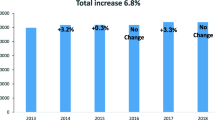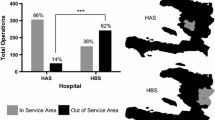Abstract
Introduction
Equitable access to surgical care is necessary for improving global health. We report on the performance, financial sustainability, and policy impact of a free-of-cost multispecialty surgical delivery program in Karachi, Pakistan built upon local private philanthropy.
Materials and Methods
We evaluated trends in surgical service delivery, expenditures, and philanthropic donations from Indus Hospital’s first 5 years of operation (2007–2012), projected these over the hospital’s current expansion phase, compared these to publicly accessible records of other philanthropic hospitals providing surgical care, and documented the government’s evolving policies toward this model.
Results
Between 2007 and 2012, Indus Hospital treated 40,012 in-patients free of cost, 33,606 (84 %) of them for surgical procedures. Surgical procedures increased fivefold to 9,478 during 2011–2012 from 1,838 during 2007–2008. Bed occupancy increased to 91 % from 65 % over the same period. External surgical missions accounted for less than 0.5 % of patients served. Ninety-eight percent (98 %) of all philanthropic donations—totaling USD 26.6 million over 2007–2012—were locally generated. Zakat (obligatory annual religious alms in the Islamic faith) constituted 34 % of all donations, followed by unrestricted funds (24 %) and donations-in-kind (24 %), buildings (12 %), grants (5 %), and return on investments (1 %). Overall, donations received between 2007 and 2012 increased sevenfold, with Zakat increasing 12-fold. During 2013–2014, the Government of Pakistan provided land lease and annual operational grants totaling USD 9 million.
Conclusions
Local philanthropy can sustain and grow the provision of free, high-quality surgical care in low-income settings, and encourage the development of hybrid government–philanthropic models of surgical care.

Similar content being viewed by others
References
Farmer PE, Kim JY (2008) Surgery and global health: a view from beyond the OR. World J Surg 32:533–536. doi:10.1007/s00268-008-9525-9
Ozgediz D, Hsia R, Weiser T et al (2009) Population health metrics for surgery: effective coverage of surgical services in low-income and middle-income countries. World J Surg 33:1–5. doi:10.1007/s00268-008-9799-y
Bickler SW, Spiegel DA (2008) Global surgery-defining a research agenda. Lancet 372:90–92
Ozgediz D, Jamison D, Cherian M et al (2008) The burden of surgical conditions and access to surgical care in low- and middle-income countries. Bull World Health Organ 86(646–64):7
Irfan F, Irfan B, Spiegel D (2012) Barriers to accessing surgical care in Pakistan: healthcare barrier model and quantitative systematic review. J Surg Res 176(84–9):4
McQueen KA, Ozgediz D, Riviello R et al (2010) Essential surgery: integral to the right to health. Health Hum Rights 12(137–15):2
Ivers LC, Garfein ES, Augustin J et al (2008) Increasing access to surgical services for the poor in rural Haiti: surgery as a public good for public health. World J Surg 32(537–54):2. doi:10.1007/s00268-008-9527-7
Funk LM, Weiser TG, Berry WR et al (2010) Global operating theatre distribution and pulse oximetry supply: an estimation from reported data. Lancet 376(1055–106):1
Myles PS, Haller G (2010) Global distribution of access to surgical services. Lancet 376(1027–102):8
Zafar S, Fatmi Z, Iqbal A et al (2013) Disparities in access to surgical care within a lower income country: an alarming inequity. World J Surg 37(1470–147):7. doi:10.1007/s00268-012-1732-8
Samad L, Jawed F, Sajun SZ et al (2013) Barriers to accessing surgical care: a cross-sectional survey conducted at a tertiary care hospital in Karachi, Pakistan. World J Surg 37:2313–2321. doi:10.1007/s00268-013-2129-z
Martiniuk AL, Manouchehrian M, Negin JA et al (2012) Brain Gains: a literature review of medical missions to low and middle-income countries. BMC Health Serv Res 12:134
Munsell M, Frank T (2006) The ORBIS flying eye hospital. J Perioper Pract 16: 120–122, 124, 126–130
Sightsavers.org. Sightsavers | International charity fighting preventable blindness. Retrieved May 2, 2013, from http://www.sightsavers.org/
Magee WP, Vander Burg R, Hatcher KW (2010) Cleft lip and palate as a cost-effective health care treatment in the developing world. World J Surg 34:420–427. doi:10.1007/s00268-009-0333-7
Hughes CD, Babigian A, McCormack S et al (2012) The clinical and economic impact of a sustained program in global plastic surgery: valuing cleft care in resource-poor settings. Plast Reconstr Surg 130:87e–94e
Aliu O, Chung KC (2012) Discussion: The clinical and economic impact of a sustained program in global plastic surgery: valuing cleft care in resource-poor settings. Plast Reconstr Surg 130:95e–97e
Corlew DS (2010) Estimation of impact of surgical disease through economic modeling of cleft lip and palate care. World J Surg 34:391–396. doi:10.1007/s00268-009-0198-9
Alkire B, Hughes CD, Nash K et al (2011) Potential economic benefit of cleft lip and palate repair in sub-Saharan Africa. World J Surg 35(1194–120):1. doi:10.1007/s00268-011-1055-1
Ramsey K, Iliyasu Z, Idoko L (2007) Fistula Fortnight: innovative partnership brings mass treatment and public awareness towards ending obstetric fistula. Int J Gynaecol Obstet 99(Suppl 1):S130–S136
Bhandari A, Dratler S, Raube K et al (2008) Specialty care systems: a pioneering vision for global health. Health Aff (Millwood) 27(964–97):6
Salter C. The World’s 50 Most Innovative Companies: 36. Narayana Hrudayalaya Hospitals for bringing medical care to the masses. Retrieved Sep 2, 2014, from http://www.fastcompany.com/3017477/most-innovative-companies-2012/36narayana-hrudayalaya-hospitals
Ahmed M, Shah M, Luby S et al (1999) Survey of surgical emergencies in a rural population in the Northern Areas of Pakistan. Trop Med Int Health 4(846–85):7
Blanchard RJ, Blanchard ME, Toussignant P et al (1987) The epidemiology and spectrum of surgical care in district hospitals of Pakistan. Am J Public Health 77(1439–144):5
Siddiqi S, Kielmann A, Khan M et al (2001) The effectiveness of patient referral in Pakistan. Health Policy Plan 16(193–19):8
Govt. of Pakistan;. National Health Accounts 2005–2006 2014 [cited 2013 May 2]. Available from: www.pbs.gov.pk/sites/default/files/…/National_Health_Accounts.pdf
Nishtar S The Gateway Paper: Health Systems in Pakistan—a Way Forward [Internet]. 2006 [cited 2012 Oct 1]. Available from: http://www.heartfile.org/pdf/phpf-GWP.pdf
World Bank World Development Indicators 20132013 [cited 2014 Sep 1]. Available from: databank.worldbank.org/data/download/WDI-2013-ebook.pdf
WHO Health System Profile—Pakistan Regional Health Systems Observatory—EMRO [Internet]. 2007 [cited 2012 Oct 1]. Available from: http://apps.who.int/medicinedocs/documents/s17305e/s17305e.pdf
10 years of building knowledge and trust Pakistan Centre for Philanthropy [Internet]. 2012 [cited 2012 Dec 1]. Available from: http://www.pcp.org.pk/pdf_word_docu/PCP’s Newsletter 2012.pdf
Khan AJ, Khowaja S, Khan FS et al (2012) Engaging the private sector to increase tuberculosis case detection: an impact evaluation study. Lancet Infect Dis 12(608–61):6
Arnquist W, Weintraub R (2012) The Indus Hospital: Delivering Free Health Care in Pakistan [Case Study and Teaching Note]. Harvard Business School Case Studies in Global Health [Internet]. Available from: http://www.ghdonline.org/cases/the-indus-hospital-delivering-free-health-care-in/
LRBT LRBT Task Ahead | Help LRBT—Give the Gift of Sight. Layton Rahmatulla Benevolent Trust., [Internet]. 2014 [cited 2014 Aug 15]. Available from: http://www.lrbt.org.pk/task-ahead/
SIUT SIUT Ramzan Brochure 2014 Sindh Institute of Urology and Transplantation [Internet]. 2014 [cited 2014 Aug 15]. Available from: http://www.siut.org/PDF/Ramzan2014-Brochure.pdf
Bonbright D, Azfar A Philanthropy in Pakistan: a report of the initiative on indigenous philanthropy. Retrieved Oct 10, 2012, from http://www.pcp.org.pk/documents/Philanthropy%20in%20Pakistan%20-%20AKDN%202000(3).pdf
Tabba Heart Institute website 2014 [cited 2014 Aug 15]. Available from: http://www.tabbaheart.org/view.php?id=142
Kassim-Lakha S, Bennett J (2013) Philanthropic funding for health in Pakistan. Lancet 381(2236–223):7
AKUH Patient Welfare Programme Aga Khan University Hospital., [Internet]. 2014 [cited 2014 Aug 15]; (Aug 15). Available from: http://hospitals.aku.edu/karachi/aboutus/SupportUs/PatientWelfareProgramme/Pages/Home.aspx
AKUH The Patients’ Behbud Society for AKUH. Aga Khan University Hospital., [Internet]. 2014 [cited 2014 Aug 15]. Available from: http://pbs.akuh.org/programmes/statistics.html
Young H ‘The case for aid? Poverty can be a catalyst for extremist views’ The Guardian. 2014 Jun 4 2014. Available from: http://www.theguardian.com/global-development-professionals-network/2013/jun/04/aid-poverty-innovative-financing
Analysis: A faith-based aid revolution in the Muslim World?. Retrieved 2013, April 30, from http://www.irinnews.org/fr/report/95564/analysis-a-faith-based-aid-revolution-in-the-muslim-world
NLM Islamic culture and the medical arts: Hospitals. Retrieved Apr 10, 2013, from http://www.nlm.nih.gov/exhibition/islamic_medical/islamic_12.html
Yusufali A, Razwy A (2000) The Quran : translation. Tahrike Tarsile Quran, Elmhurst
Individual philanthropy in the Punjab. Pakistan Centre for Philanthropy [Internet]. 2010 [cited 2012 Dec 1]. Available from: http://www.pcp/org.pk/pdf_word_docu/Individual Philanthropy in the Punjab.pdf
The Future of the Global Muslim Population: Projections for 2010–2013. Retrieved May 30, 2013, from http://www.pewforum.org/2011/01/27/the-future-of-the-global-muslim-population/
Inauguration of 100 days Master plan for the Development of Islamic Microfinance industry Retrieved April 30, 2013, from http://www.pr-inside.com/print3682744.htm
Acknowledgments
The authors recognize the contribution of the founders of Indus Hospital, Drs Abdul Bari Khan, Syed Zafar Zaidi, Muhammad Amin Chinoy, and Akhtar Aziz Khan. The authors appreciate their support and that of the board of directors in allowing the data to be publicly shared. The authors would like to thank Ismat Lotia-Farrukh, Zara Ansari, and John Meara for their contributions to the manuscript. Finally, the authors acknowledge the commitment of the many dedicated staff and donors of Indus Hospital.
Conflicts of interests
The authors of this paper declare that there are no conflicts of interests.
Funding
Funding was provided by Indus Hospital and IRD.
Author information
Authors and Affiliations
Corresponding author
Rights and permissions
About this article
Cite this article
Samad, L., Iqbal, M., Tariq, A. et al. Equitable Access to Comprehensive Surgical Care: The Potential of Indigenous Private Philanthropy in Low-Income Settings. World J Surg 39, 21–28 (2015). https://doi.org/10.1007/s00268-014-2852-0
Published:
Issue Date:
DOI: https://doi.org/10.1007/s00268-014-2852-0




